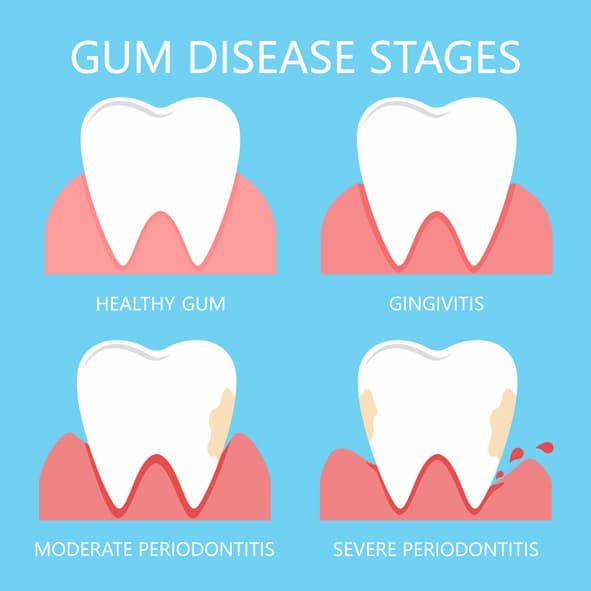 Many people suffer from gum disease but may be unaware that they have this serious infection. Periodontal diseases are infections of the gum tissue, and they can cause destruction of the bone that supports teeth. A major indicator of gum disease is inflammation, which is the body’s way of shielding, guarding and protecting itself from infection. It is important for individuals to recognize the signs and symptoms of gum disease.
Many people suffer from gum disease but may be unaware that they have this serious infection. Periodontal diseases are infections of the gum tissue, and they can cause destruction of the bone that supports teeth. A major indicator of gum disease is inflammation, which is the body’s way of shielding, guarding and protecting itself from infection. It is important for individuals to recognize the signs and symptoms of gum disease.
What Causes Gum Disease?
Periodontal diseases are caused by bacterial plaque, a sticky film that continuously forms around the teeth. When bacterial plaque settles over time, it hardens into dental calculus, known as tartar. In the ideal healthy mouth, the gum tissues and bone fit snugly around the teeth; however, when periodontal disease is manifested, the bone and gum tissues can become damaged and form larger pockets around the teeth. As time progresses, these pockets can become deeper, which enables the bacterial plaque to settle and thrive. Most bacterial plaque can be removed through daily brushing, flossing and routine dental cleanings, all of which can help stem the risk of gum disease.
Whom Does Gum Disease Affect?
Periodontal disease can affect both children and adults. There are approximately 64.7 million Americans who have periodontitis, according to research from the Centers for Disease Control and Prevention. The research from the CDC also suggests that periodontal disease is more common in men (56.4 per cent) than in women (38.4 per cent). The most common and prevalent form of periodontal disease among both children and adolescents is gingivitis.
Signs and Symptoms
Periodontal diseases in some people can be painless; therefore, it is important for you to be aware of any of the following symptoms:
- Bleeding: Gums that easily bleed when brushing or flossing.
- Puffiness: Swollen, red or tender gums.
- Recession: Gum tissue that moves away from the tooth.
- Bad breath: Persistent bad breath or a bad taste in the mouth.
- Loose teeth: Permanent teeth that can be moved back and forth or shifted.
- Poorly fitting teeth: A change in the way your teeth fit together.
- Poorly fitting partial dentures: A change in the fit of partial dentures.
- Pus: Visible pus surrounding teeth and gums.
- Painful chewing: Sharp or dull pains when chewing foods.
- Teeth sensitivity: Teeth that are overly sensitive to cold or hot temperatures.
Contributing Factors
There are certain factors that can contribute to an increase in the risk of developing periodontal diseases, such as stress, genetics and age. The use of tobacco products, poor oral hygiene, and poor nutrition can all affect the gums. Also, women who are pregnant are more likely to be at risk of periodontal diseases due to changes in their body’s hormonal levels. Bacterial plaque can be held in place around crooked teeth, poorly fitting bridges and fillings that are worn or cracked. The use of certain medications, such as drugs for cancer therapy, steroids, some calcium channel blockers and some anti-epilepsy drugs can contribute to periodontal diseases.
Oral-Systemic Link
Scientific evidence links certain systemic diseases with periodontal disease. Research suggests that the risk of heart disease increases with individuals who have periodontal disease. Respiratory diseases have been linked with periodontal diseases due to oral bacteria, which can be aspirated into the lungs and cause pneumonia. Diabetic patients can be more prone to periodontal disease, which increases complications from diabetes and blood sugar levels.
Forms of Gum Disease
There are different forms of periodontal disease, but the following are the most common:
- Chronic gingivitis: A reversible, milder form of periodontal disease marked by inflammation, redness and bleeding of the gums. (There is no bone loss with gingivitis.)
- Aggressive periodontitis: Rapid loss of gum attachment and bone destruction in a short period.
- Chronic periodontitis: The most common and advanced form of periodontitis — progresses slowly.
- Necrotizing periodontal disease: An infection resulting from death (necrosis) of gum tissues surrounding the tooth and connecting bone. (Common symptoms are a foul odour and painful bleeding gums.)
Gum Disease Treatment
A dentist or periodontist may recommend certain procedures after diagnosing, determining the prognosis and facilitating a treatment plan. One treatment method for periodontal disease is accomplished by scaling and root planning or nonsurgical periodontal therapy, which accomplishes the removal of bacterial plaque and dental calculus (tartar) from the root surfaces through procedures using hand, sonic and ultrasonic instruments.
Dental Visits
Routine dental visits should occur at least once a year, but it is recommended to become more frequent if you experience any of the above symptoms. The state of your periodontal health can be determined when a comprehensive evaluation is performed by your dentist, periodontist or dental hygienist. After scaling and root planing or surgery, follow-up visits are necessary to re-examine your periodontal health status.
